An Analysis of Leadership and Management in Clarasys Ltd Operations
VerifiedAdded on 2021/02/21
|13
|3550
|30
Report
AI Summary
This report provides a comprehensive analysis of leadership and management within Clarasys Ltd, a London-based management consultancy. It begins by differentiating between the roles and characteristics of leaders and managers, examining their respective functions and responsibilities in guiding and directing employees to achieve business objectives. The report then delves into the practical application of leadership and management in situational contexts, such as conflict resolution and rapid change scenarios, illustrating how managers and leaders can utilize their skills to navigate these challenges. Furthermore, it explores various leadership theories and models, including situational, systems, and contingency leadership, evaluating their strengths and weaknesses and their applicability within Clarasys Ltd. Finally, the report examines key approaches to operations management, such as Total Quality Management (TQM), highlighting the roles that leaders and managers play in ensuring operational efficiency and excellence. The analysis provides a valuable insight into the practical application of leadership and management principles in a real-world business environment.
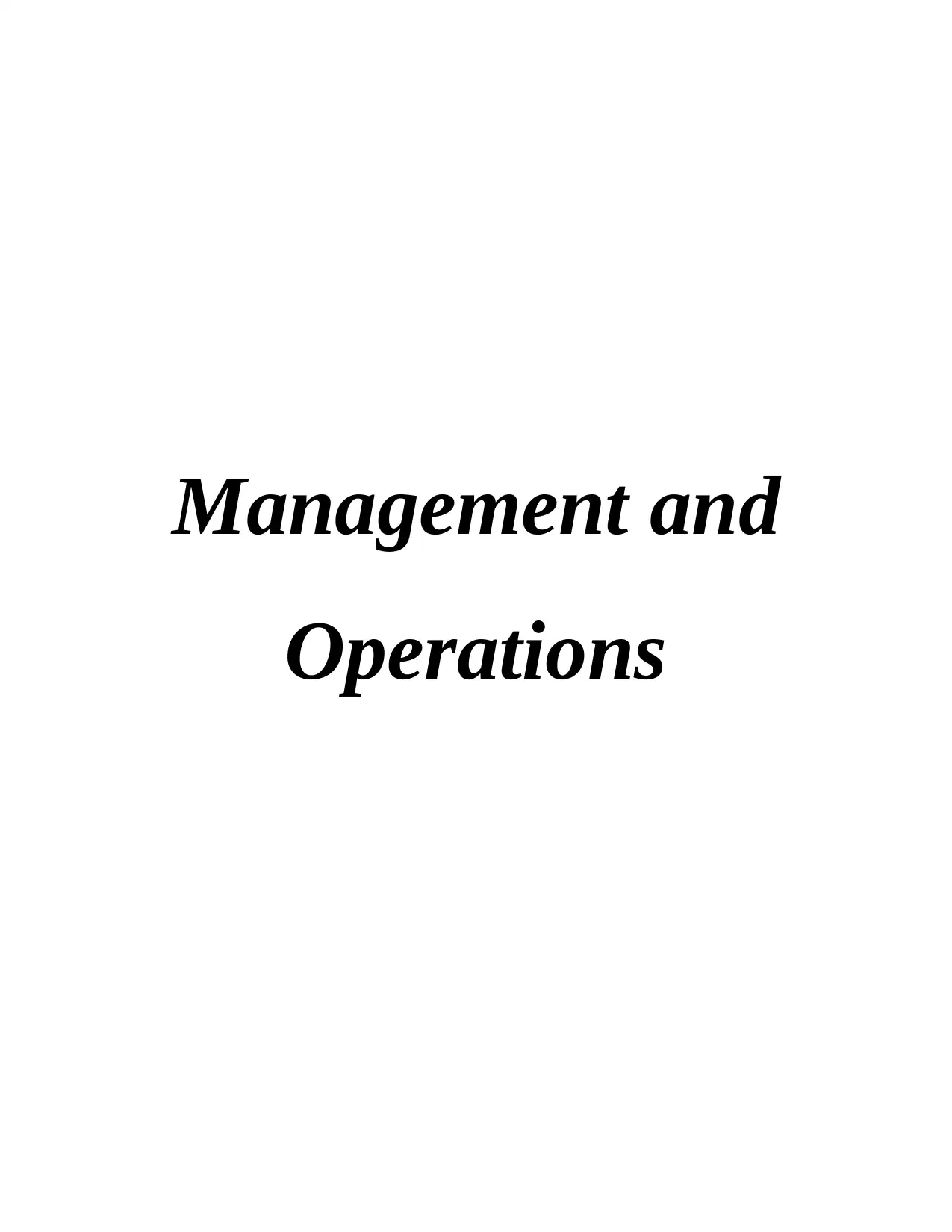
Management and
Operations
Operations
Paraphrase This Document
Need a fresh take? Get an instant paraphrase of this document with our AI Paraphraser
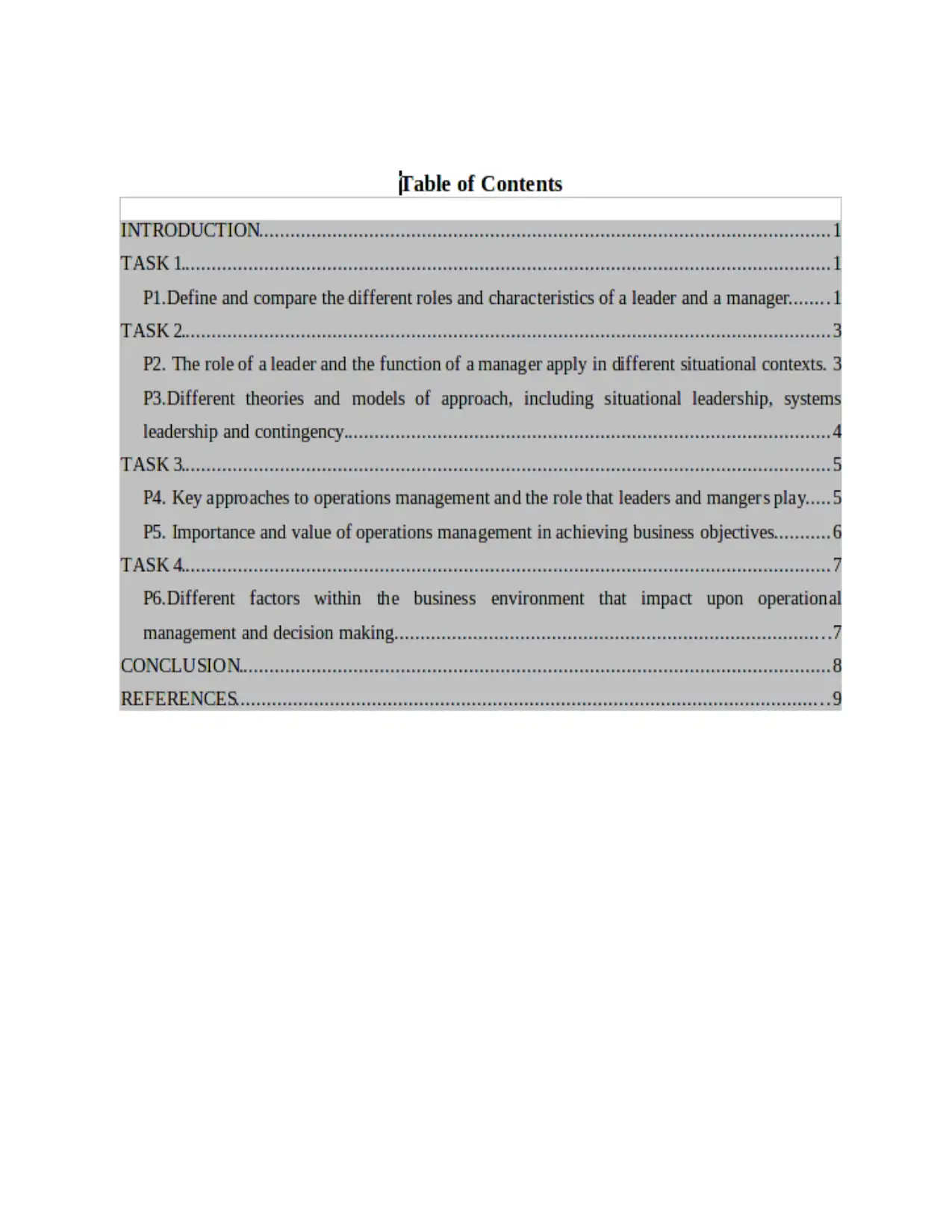
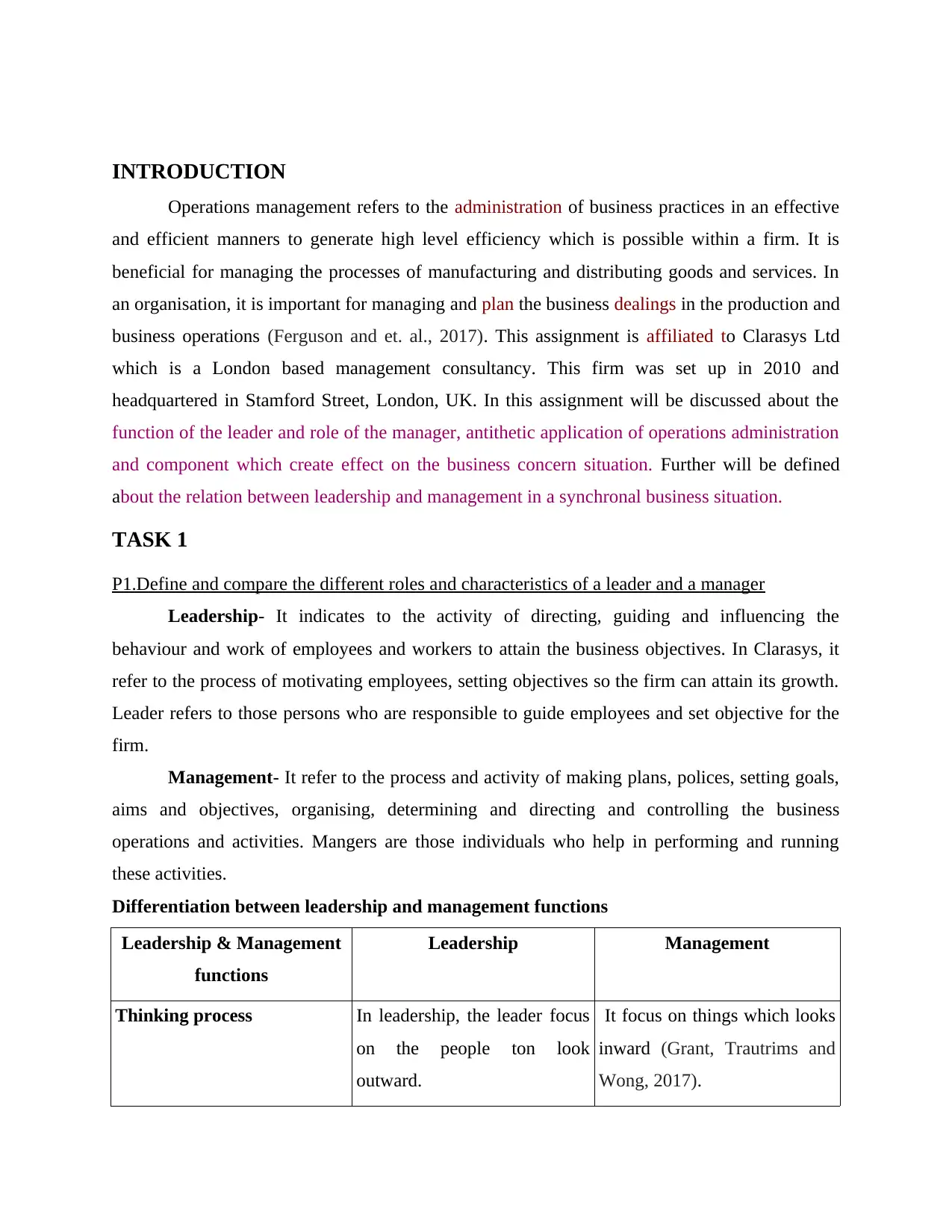
INTRODUCTION
Operations management refers to the administration of business practices in an effective
and efficient manners to generate high level efficiency which is possible within a firm. It is
beneficial for managing the processes of manufacturing and distributing goods and services. In
an organisation, it is important for managing and plan the business dealings in the production and
business operations (Ferguson and et. al., 2017). This assignment is affiliated to Clarasys Ltd
which is a London based management consultancy. This firm was set up in 2010 and
headquartered in Stamford Street, London, UK. In this assignment will be discussed about the
function of the leader and role of the manager, antithetic application of operations administration
and component which create effect on the business concern situation. Further will be defined
about the relation between leadership and management in a synchronal business situation.
TASK 1
P1.Define and compare the different roles and characteristics of a leader and a manager
Leadership- It indicates to the activity of directing, guiding and influencing the
behaviour and work of employees and workers to attain the business objectives. In Clarasys, it
refer to the process of motivating employees, setting objectives so the firm can attain its growth.
Leader refers to those persons who are responsible to guide employees and set objective for the
firm.
Management- It refer to the process and activity of making plans, polices, setting goals,
aims and objectives, organising, determining and directing and controlling the business
operations and activities. Mangers are those individuals who help in performing and running
these activities.
Differentiation between leadership and management functions
Leadership & Management
functions
Leadership Management
Thinking process In leadership, the leader focus
on the people ton look
outward.
It focus on things which looks
inward (Grant, Trautrims and
Wong, 2017).
Operations management refers to the administration of business practices in an effective
and efficient manners to generate high level efficiency which is possible within a firm. It is
beneficial for managing the processes of manufacturing and distributing goods and services. In
an organisation, it is important for managing and plan the business dealings in the production and
business operations (Ferguson and et. al., 2017). This assignment is affiliated to Clarasys Ltd
which is a London based management consultancy. This firm was set up in 2010 and
headquartered in Stamford Street, London, UK. In this assignment will be discussed about the
function of the leader and role of the manager, antithetic application of operations administration
and component which create effect on the business concern situation. Further will be defined
about the relation between leadership and management in a synchronal business situation.
TASK 1
P1.Define and compare the different roles and characteristics of a leader and a manager
Leadership- It indicates to the activity of directing, guiding and influencing the
behaviour and work of employees and workers to attain the business objectives. In Clarasys, it
refer to the process of motivating employees, setting objectives so the firm can attain its growth.
Leader refers to those persons who are responsible to guide employees and set objective for the
firm.
Management- It refer to the process and activity of making plans, polices, setting goals,
aims and objectives, organising, determining and directing and controlling the business
operations and activities. Mangers are those individuals who help in performing and running
these activities.
Differentiation between leadership and management functions
Leadership & Management
functions
Leadership Management
Thinking process In leadership, the leader focus
on the people ton look
outward.
It focus on things which looks
inward (Grant, Trautrims and
Wong, 2017).
⊘ This is a preview!⊘
Do you want full access?
Subscribe today to unlock all pages.

Trusted by 1+ million students worldwide
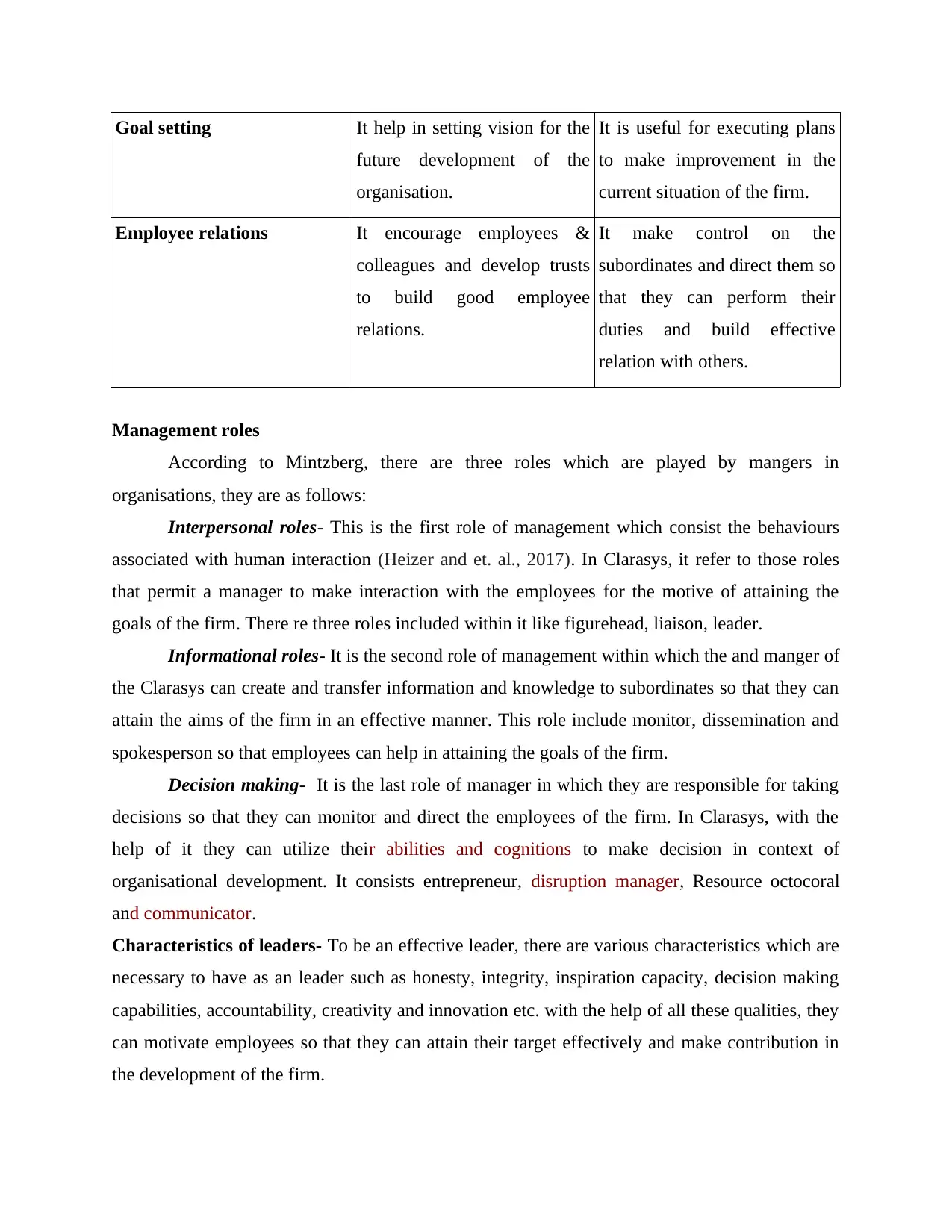
Goal setting It help in setting vision for the
future development of the
organisation.
It is useful for executing plans
to make improvement in the
current situation of the firm.
Employee relations It encourage employees &
colleagues and develop trusts
to build good employee
relations.
It make control on the
subordinates and direct them so
that they can perform their
duties and build effective
relation with others.
Management roles
According to Mintzberg, there are three roles which are played by mangers in
organisations, they are as follows:
Interpersonal roles- This is the first role of management which consist the behaviours
associated with human interaction (Heizer and et. al., 2017). In Clarasys, it refer to those roles
that permit a manager to make interaction with the employees for the motive of attaining the
goals of the firm. There re three roles included within it like figurehead, liaison, leader.
Informational roles- It is the second role of management within which the and manger of
the Clarasys can create and transfer information and knowledge to subordinates so that they can
attain the aims of the firm in an effective manner. This role include monitor, dissemination and
spokesperson so that employees can help in attaining the goals of the firm.
Decision making- It is the last role of manager in which they are responsible for taking
decisions so that they can monitor and direct the employees of the firm. In Clarasys, with the
help of it they can utilize their abilities and cognitions to make decision in context of
organisational development. It consists entrepreneur, disruption manager, Resource octocoral
and communicator.
Characteristics of leaders- To be an effective leader, there are various characteristics which are
necessary to have as an leader such as honesty, integrity, inspiration capacity, decision making
capabilities, accountability, creativity and innovation etc. with the help of all these qualities, they
can motivate employees so that they can attain their target effectively and make contribution in
the development of the firm.
future development of the
organisation.
It is useful for executing plans
to make improvement in the
current situation of the firm.
Employee relations It encourage employees &
colleagues and develop trusts
to build good employee
relations.
It make control on the
subordinates and direct them so
that they can perform their
duties and build effective
relation with others.
Management roles
According to Mintzberg, there are three roles which are played by mangers in
organisations, they are as follows:
Interpersonal roles- This is the first role of management which consist the behaviours
associated with human interaction (Heizer and et. al., 2017). In Clarasys, it refer to those roles
that permit a manager to make interaction with the employees for the motive of attaining the
goals of the firm. There re three roles included within it like figurehead, liaison, leader.
Informational roles- It is the second role of management within which the and manger of
the Clarasys can create and transfer information and knowledge to subordinates so that they can
attain the aims of the firm in an effective manner. This role include monitor, dissemination and
spokesperson so that employees can help in attaining the goals of the firm.
Decision making- It is the last role of manager in which they are responsible for taking
decisions so that they can monitor and direct the employees of the firm. In Clarasys, with the
help of it they can utilize their abilities and cognitions to make decision in context of
organisational development. It consists entrepreneur, disruption manager, Resource octocoral
and communicator.
Characteristics of leaders- To be an effective leader, there are various characteristics which are
necessary to have as an leader such as honesty, integrity, inspiration capacity, decision making
capabilities, accountability, creativity and innovation etc. with the help of all these qualities, they
can motivate employees so that they can attain their target effectively and make contribution in
the development of the firm.
Paraphrase This Document
Need a fresh take? Get an instant paraphrase of this document with our AI Paraphraser
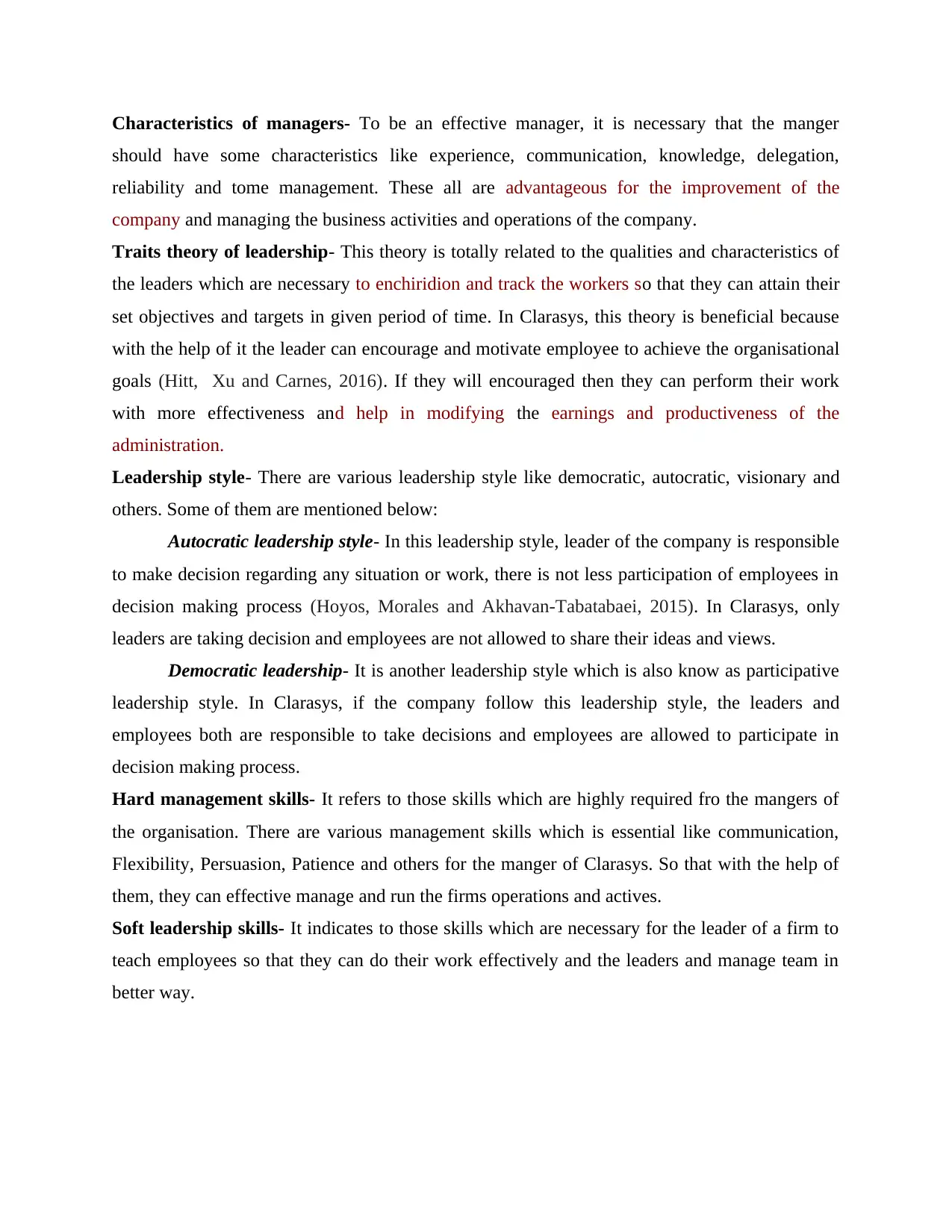
Characteristics of managers- To be an effective manager, it is necessary that the manger
should have some characteristics like experience, communication, knowledge, delegation,
reliability and tome management. These all are advantageous for the improvement of the
company and managing the business activities and operations of the company.
Traits theory of leadership- This theory is totally related to the qualities and characteristics of
the leaders which are necessary to enchiridion and track the workers so that they can attain their
set objectives and targets in given period of time. In Clarasys, this theory is beneficial because
with the help of it the leader can encourage and motivate employee to achieve the organisational
goals (Hitt, Xu and Carnes, 2016). If they will encouraged then they can perform their work
with more effectiveness and help in modifying the earnings and productiveness of the
administration.
Leadership style- There are various leadership style like democratic, autocratic, visionary and
others. Some of them are mentioned below:
Autocratic leadership style- In this leadership style, leader of the company is responsible
to make decision regarding any situation or work, there is not less participation of employees in
decision making process (Hoyos, Morales and Akhavan-Tabatabaei, 2015). In Clarasys, only
leaders are taking decision and employees are not allowed to share their ideas and views.
Democratic leadership- It is another leadership style which is also know as participative
leadership style. In Clarasys, if the company follow this leadership style, the leaders and
employees both are responsible to take decisions and employees are allowed to participate in
decision making process.
Hard management skills- It refers to those skills which are highly required fro the mangers of
the organisation. There are various management skills which is essential like communication,
Flexibility, Persuasion, Patience and others for the manger of Clarasys. So that with the help of
them, they can effective manage and run the firms operations and actives.
Soft leadership skills- It indicates to those skills which are necessary for the leader of a firm to
teach employees so that they can do their work effectively and the leaders and manage team in
better way.
should have some characteristics like experience, communication, knowledge, delegation,
reliability and tome management. These all are advantageous for the improvement of the
company and managing the business activities and operations of the company.
Traits theory of leadership- This theory is totally related to the qualities and characteristics of
the leaders which are necessary to enchiridion and track the workers so that they can attain their
set objectives and targets in given period of time. In Clarasys, this theory is beneficial because
with the help of it the leader can encourage and motivate employee to achieve the organisational
goals (Hitt, Xu and Carnes, 2016). If they will encouraged then they can perform their work
with more effectiveness and help in modifying the earnings and productiveness of the
administration.
Leadership style- There are various leadership style like democratic, autocratic, visionary and
others. Some of them are mentioned below:
Autocratic leadership style- In this leadership style, leader of the company is responsible
to make decision regarding any situation or work, there is not less participation of employees in
decision making process (Hoyos, Morales and Akhavan-Tabatabaei, 2015). In Clarasys, only
leaders are taking decision and employees are not allowed to share their ideas and views.
Democratic leadership- It is another leadership style which is also know as participative
leadership style. In Clarasys, if the company follow this leadership style, the leaders and
employees both are responsible to take decisions and employees are allowed to participate in
decision making process.
Hard management skills- It refers to those skills which are highly required fro the mangers of
the organisation. There are various management skills which is essential like communication,
Flexibility, Persuasion, Patience and others for the manger of Clarasys. So that with the help of
them, they can effective manage and run the firms operations and actives.
Soft leadership skills- It indicates to those skills which are necessary for the leader of a firm to
teach employees so that they can do their work effectively and the leaders and manage team in
better way.
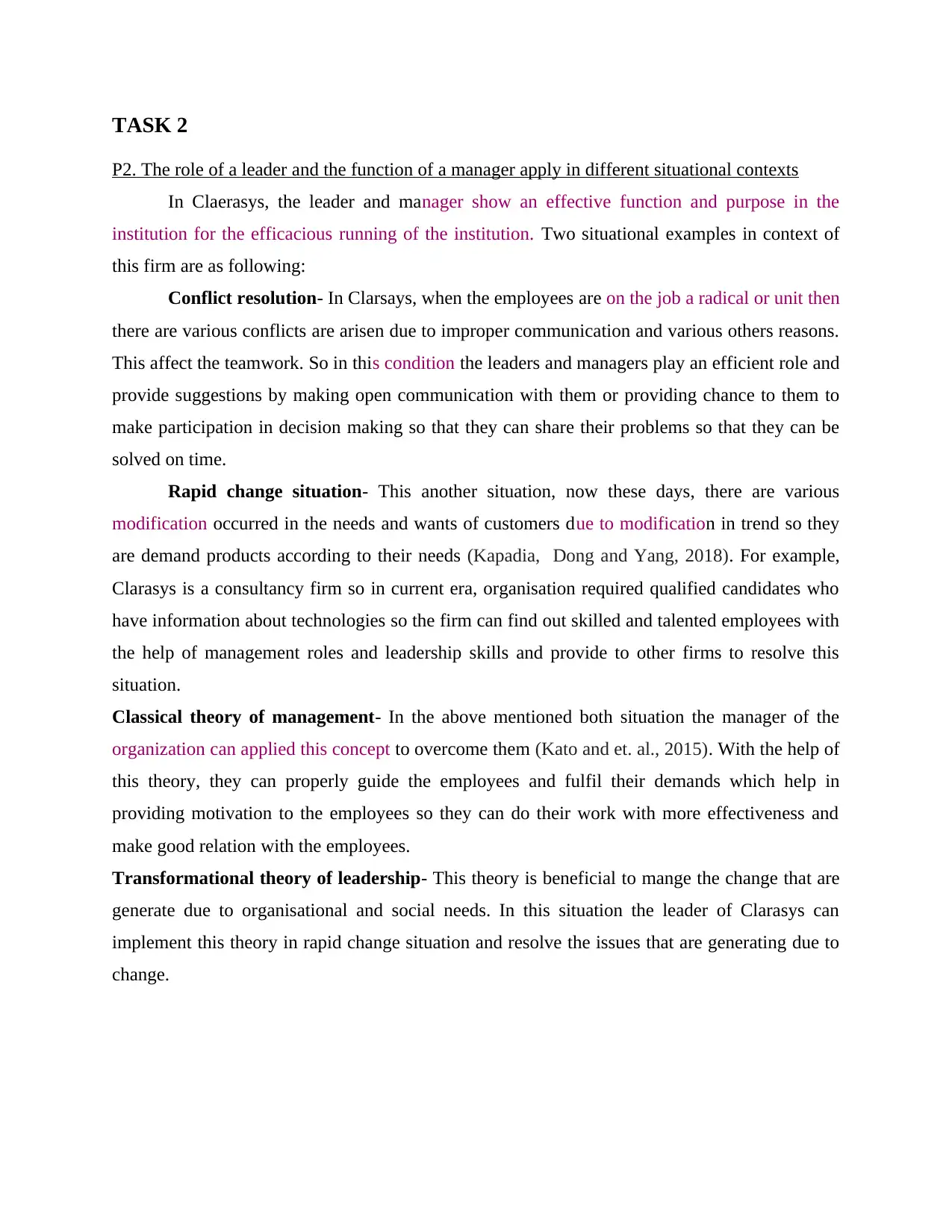
TASK 2
P2. The role of a leader and the function of a manager apply in different situational contexts
In Claerasys, the leader and manager show an effective function and purpose in the
institution for the efficacious running of the institution. Two situational examples in context of
this firm are as following:
Conflict resolution- In Clarsays, when the employees are on the job a radical or unit then
there are various conflicts are arisen due to improper communication and various others reasons.
This affect the teamwork. So in this condition the leaders and managers play an efficient role and
provide suggestions by making open communication with them or providing chance to them to
make participation in decision making so that they can share their problems so that they can be
solved on time.
Rapid change situation- This another situation, now these days, there are various
modification occurred in the needs and wants of customers due to modification in trend so they
are demand products according to their needs (Kapadia, Dong and Yang, 2018). For example,
Clarasys is a consultancy firm so in current era, organisation required qualified candidates who
have information about technologies so the firm can find out skilled and talented employees with
the help of management roles and leadership skills and provide to other firms to resolve this
situation.
Classical theory of management- In the above mentioned both situation the manager of the
organization can applied this concept to overcome them (Kato and et. al., 2015). With the help of
this theory, they can properly guide the employees and fulfil their demands which help in
providing motivation to the employees so they can do their work with more effectiveness and
make good relation with the employees.
Transformational theory of leadership- This theory is beneficial to mange the change that are
generate due to organisational and social needs. In this situation the leader of Clarasys can
implement this theory in rapid change situation and resolve the issues that are generating due to
change.
P2. The role of a leader and the function of a manager apply in different situational contexts
In Claerasys, the leader and manager show an effective function and purpose in the
institution for the efficacious running of the institution. Two situational examples in context of
this firm are as following:
Conflict resolution- In Clarsays, when the employees are on the job a radical or unit then
there are various conflicts are arisen due to improper communication and various others reasons.
This affect the teamwork. So in this condition the leaders and managers play an efficient role and
provide suggestions by making open communication with them or providing chance to them to
make participation in decision making so that they can share their problems so that they can be
solved on time.
Rapid change situation- This another situation, now these days, there are various
modification occurred in the needs and wants of customers due to modification in trend so they
are demand products according to their needs (Kapadia, Dong and Yang, 2018). For example,
Clarasys is a consultancy firm so in current era, organisation required qualified candidates who
have information about technologies so the firm can find out skilled and talented employees with
the help of management roles and leadership skills and provide to other firms to resolve this
situation.
Classical theory of management- In the above mentioned both situation the manager of the
organization can applied this concept to overcome them (Kato and et. al., 2015). With the help of
this theory, they can properly guide the employees and fulfil their demands which help in
providing motivation to the employees so they can do their work with more effectiveness and
make good relation with the employees.
Transformational theory of leadership- This theory is beneficial to mange the change that are
generate due to organisational and social needs. In this situation the leader of Clarasys can
implement this theory in rapid change situation and resolve the issues that are generating due to
change.
⊘ This is a preview!⊘
Do you want full access?
Subscribe today to unlock all pages.

Trusted by 1+ million students worldwide
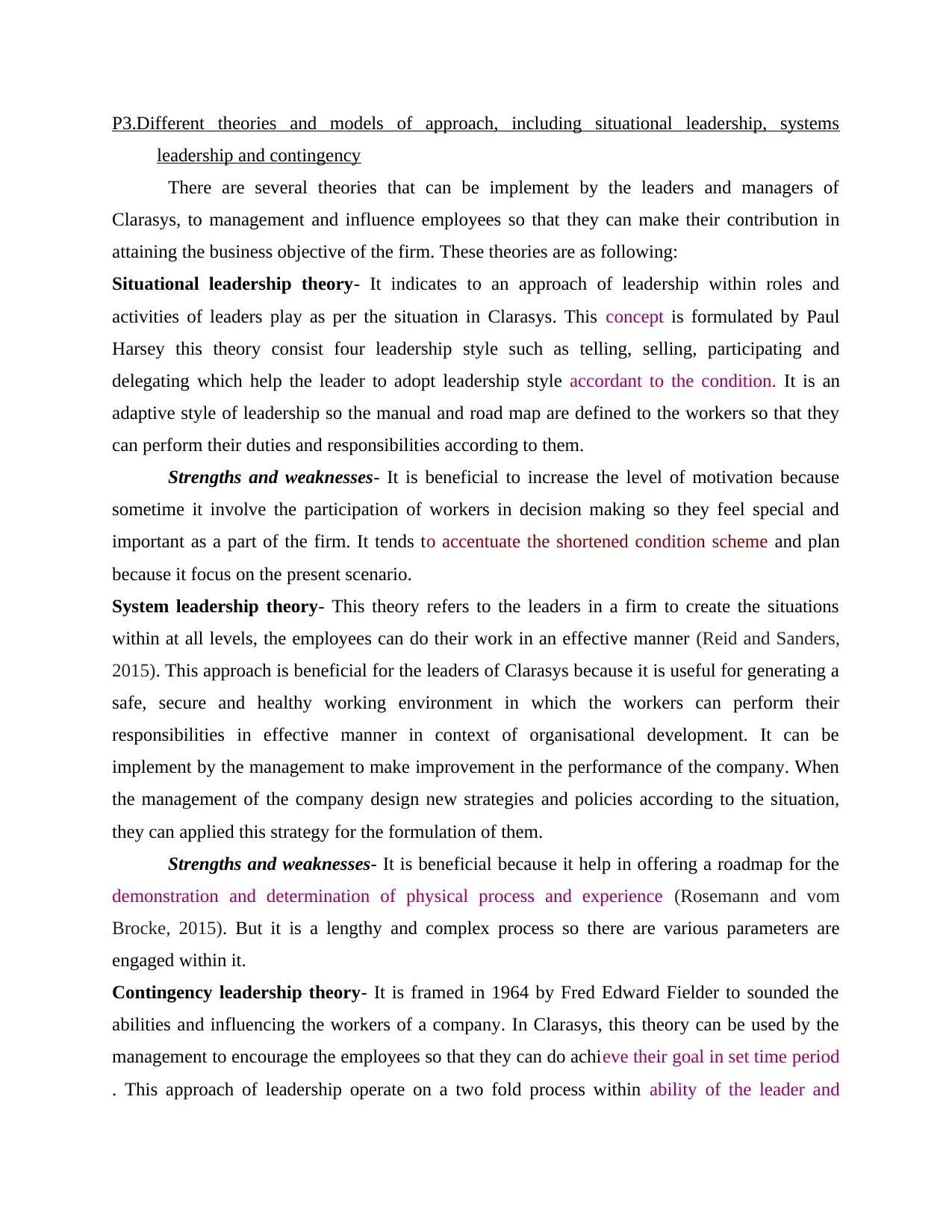
P3.Different theories and models of approach, including situational leadership, systems
leadership and contingency
There are several theories that can be implement by the leaders and managers of
Clarasys, to management and influence employees so that they can make their contribution in
attaining the business objective of the firm. These theories are as following:
Situational leadership theory- It indicates to an approach of leadership within roles and
activities of leaders play as per the situation in Clarasys. This concept is formulated by Paul
Harsey this theory consist four leadership style such as telling, selling, participating and
delegating which help the leader to adopt leadership style accordant to the condition. It is an
adaptive style of leadership so the manual and road map are defined to the workers so that they
can perform their duties and responsibilities according to them.
Strengths and weaknesses- It is beneficial to increase the level of motivation because
sometime it involve the participation of workers in decision making so they feel special and
important as a part of the firm. It tends to accentuate the shortened condition scheme and plan
because it focus on the present scenario.
System leadership theory- This theory refers to the leaders in a firm to create the situations
within at all levels, the employees can do their work in an effective manner (Reid and Sanders,
2015). This approach is beneficial for the leaders of Clarasys because it is useful for generating a
safe, secure and healthy working environment in which the workers can perform their
responsibilities in effective manner in context of organisational development. It can be
implement by the management to make improvement in the performance of the company. When
the management of the company design new strategies and policies according to the situation,
they can applied this strategy for the formulation of them.
Strengths and weaknesses- It is beneficial because it help in offering a roadmap for the
demonstration and determination of physical process and experience (Rosemann and vom
Brocke, 2015). But it is a lengthy and complex process so there are various parameters are
engaged within it.
Contingency leadership theory- It is framed in 1964 by Fred Edward Fielder to sounded the
abilities and influencing the workers of a company. In Clarasys, this theory can be used by the
management to encourage the employees so that they can do achieve their goal in set time period
. This approach of leadership operate on a two fold process within ability of the leader and
leadership and contingency
There are several theories that can be implement by the leaders and managers of
Clarasys, to management and influence employees so that they can make their contribution in
attaining the business objective of the firm. These theories are as following:
Situational leadership theory- It indicates to an approach of leadership within roles and
activities of leaders play as per the situation in Clarasys. This concept is formulated by Paul
Harsey this theory consist four leadership style such as telling, selling, participating and
delegating which help the leader to adopt leadership style accordant to the condition. It is an
adaptive style of leadership so the manual and road map are defined to the workers so that they
can perform their duties and responsibilities according to them.
Strengths and weaknesses- It is beneficial to increase the level of motivation because
sometime it involve the participation of workers in decision making so they feel special and
important as a part of the firm. It tends to accentuate the shortened condition scheme and plan
because it focus on the present scenario.
System leadership theory- This theory refers to the leaders in a firm to create the situations
within at all levels, the employees can do their work in an effective manner (Reid and Sanders,
2015). This approach is beneficial for the leaders of Clarasys because it is useful for generating a
safe, secure and healthy working environment in which the workers can perform their
responsibilities in effective manner in context of organisational development. It can be
implement by the management to make improvement in the performance of the company. When
the management of the company design new strategies and policies according to the situation,
they can applied this strategy for the formulation of them.
Strengths and weaknesses- It is beneficial because it help in offering a roadmap for the
demonstration and determination of physical process and experience (Rosemann and vom
Brocke, 2015). But it is a lengthy and complex process so there are various parameters are
engaged within it.
Contingency leadership theory- It is framed in 1964 by Fred Edward Fielder to sounded the
abilities and influencing the workers of a company. In Clarasys, this theory can be used by the
management to encourage the employees so that they can do achieve their goal in set time period
. This approach of leadership operate on a two fold process within ability of the leader and
Paraphrase This Document
Need a fresh take? Get an instant paraphrase of this document with our AI Paraphraser
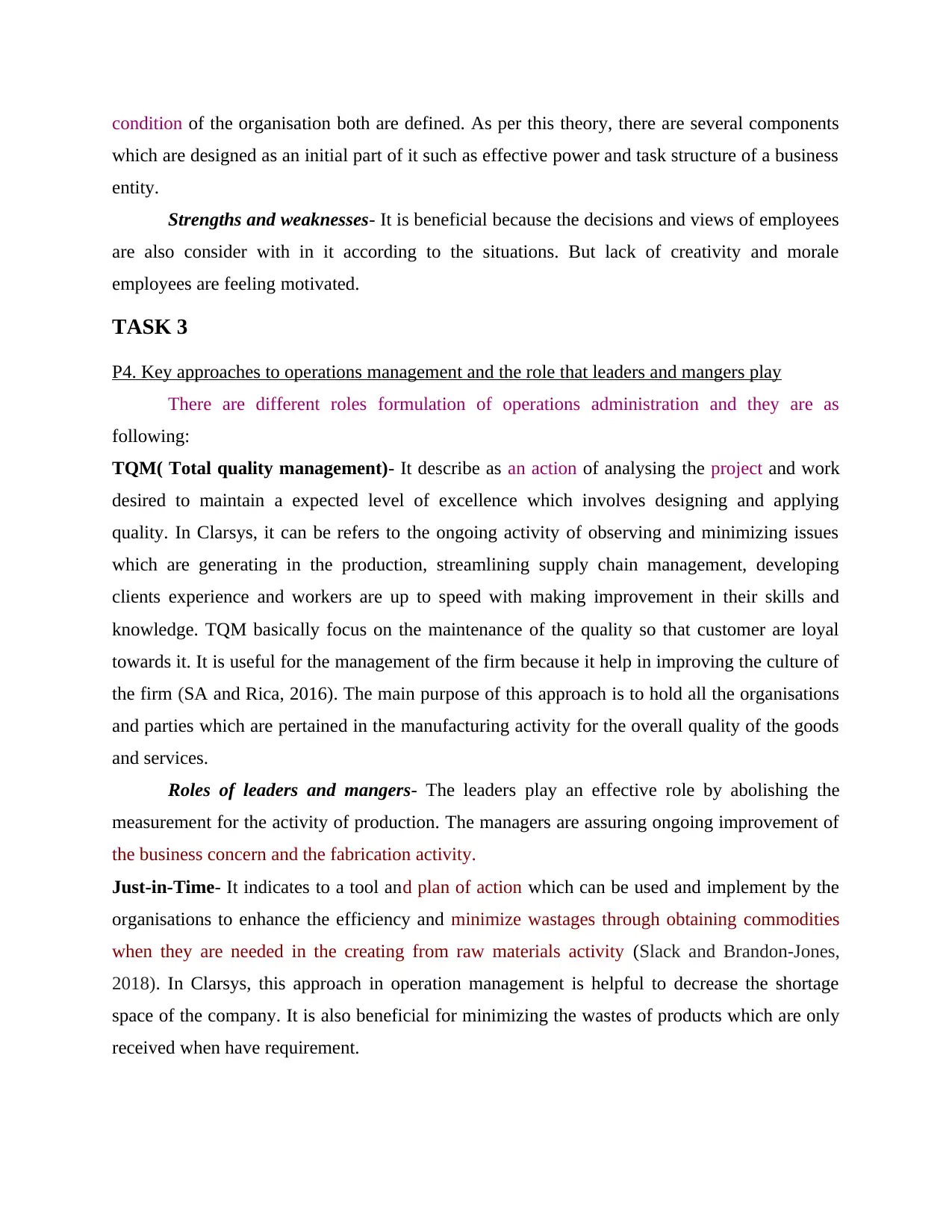
condition of the organisation both are defined. As per this theory, there are several components
which are designed as an initial part of it such as effective power and task structure of a business
entity.
Strengths and weaknesses- It is beneficial because the decisions and views of employees
are also consider with in it according to the situations. But lack of creativity and morale
employees are feeling motivated.
TASK 3
P4. Key approaches to operations management and the role that leaders and mangers play
There are different roles formulation of operations administration and they are as
following:
TQM( Total quality management)- It describe as an action of analysing the project and work
desired to maintain a expected level of excellence which involves designing and applying
quality. In Clarsys, it can be refers to the ongoing activity of observing and minimizing issues
which are generating in the production, streamlining supply chain management, developing
clients experience and workers are up to speed with making improvement in their skills and
knowledge. TQM basically focus on the maintenance of the quality so that customer are loyal
towards it. It is useful for the management of the firm because it help in improving the culture of
the firm (SA and Rica, 2016). The main purpose of this approach is to hold all the organisations
and parties which are pertained in the manufacturing activity for the overall quality of the goods
and services.
Roles of leaders and mangers- The leaders play an effective role by abolishing the
measurement for the activity of production. The managers are assuring ongoing improvement of
the business concern and the fabrication activity.
Just-in-Time- It indicates to a tool and plan of action which can be used and implement by the
organisations to enhance the efficiency and minimize wastages through obtaining commodities
when they are needed in the creating from raw materials activity (Slack and Brandon-Jones,
2018). In Clarsys, this approach in operation management is helpful to decrease the shortage
space of the company. It is also beneficial for minimizing the wastes of products which are only
received when have requirement.
which are designed as an initial part of it such as effective power and task structure of a business
entity.
Strengths and weaknesses- It is beneficial because the decisions and views of employees
are also consider with in it according to the situations. But lack of creativity and morale
employees are feeling motivated.
TASK 3
P4. Key approaches to operations management and the role that leaders and mangers play
There are different roles formulation of operations administration and they are as
following:
TQM( Total quality management)- It describe as an action of analysing the project and work
desired to maintain a expected level of excellence which involves designing and applying
quality. In Clarsys, it can be refers to the ongoing activity of observing and minimizing issues
which are generating in the production, streamlining supply chain management, developing
clients experience and workers are up to speed with making improvement in their skills and
knowledge. TQM basically focus on the maintenance of the quality so that customer are loyal
towards it. It is useful for the management of the firm because it help in improving the culture of
the firm (SA and Rica, 2016). The main purpose of this approach is to hold all the organisations
and parties which are pertained in the manufacturing activity for the overall quality of the goods
and services.
Roles of leaders and mangers- The leaders play an effective role by abolishing the
measurement for the activity of production. The managers are assuring ongoing improvement of
the business concern and the fabrication activity.
Just-in-Time- It indicates to a tool and plan of action which can be used and implement by the
organisations to enhance the efficiency and minimize wastages through obtaining commodities
when they are needed in the creating from raw materials activity (Slack and Brandon-Jones,
2018). In Clarsys, this approach in operation management is helpful to decrease the shortage
space of the company. It is also beneficial for minimizing the wastes of products which are only
received when have requirement.
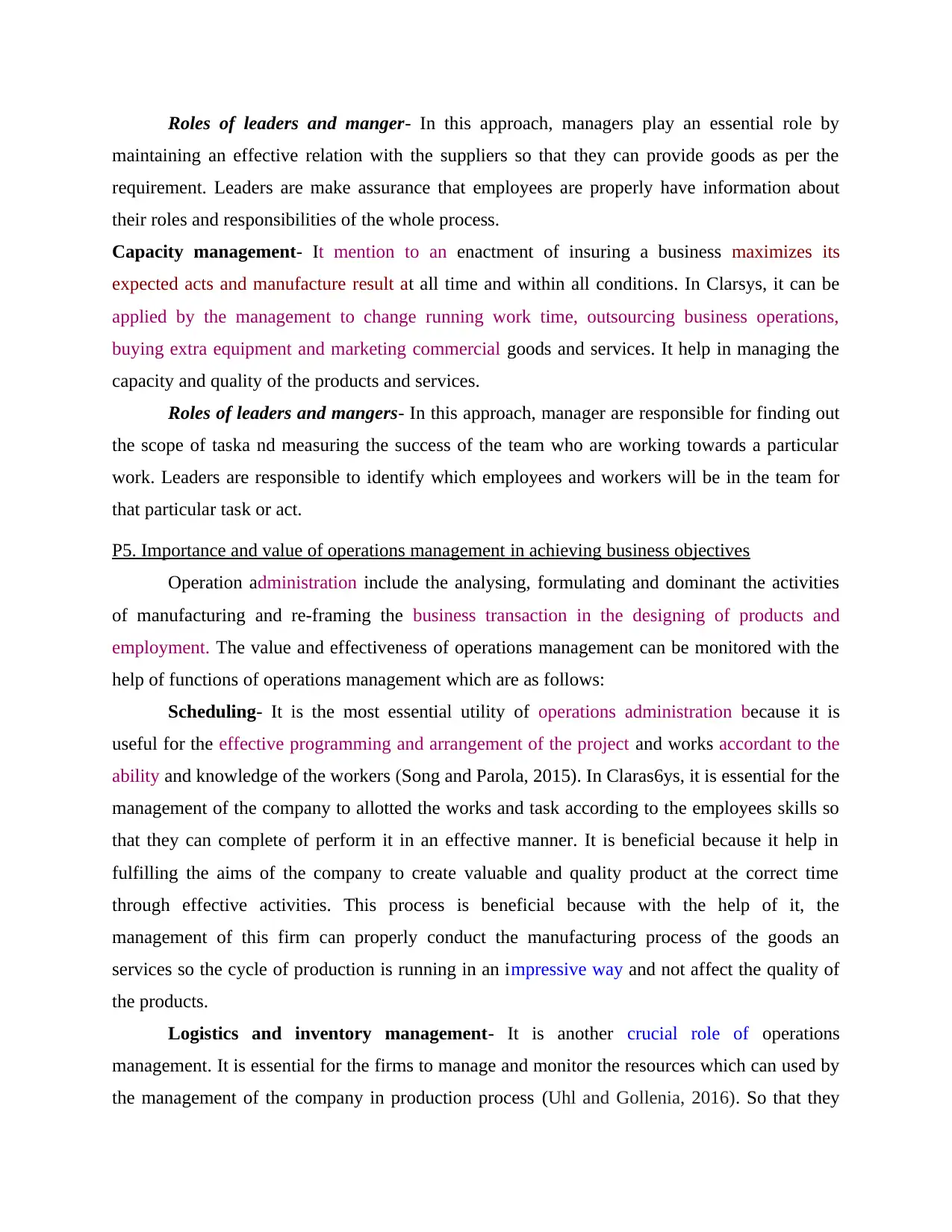
Roles of leaders and manger- In this approach, managers play an essential role by
maintaining an effective relation with the suppliers so that they can provide goods as per the
requirement. Leaders are make assurance that employees are properly have information about
their roles and responsibilities of the whole process.
Capacity management- It mention to an enactment of insuring a business maximizes its
expected acts and manufacture result at all time and within all conditions. In Clarsys, it can be
applied by the management to change running work time, outsourcing business operations,
buying extra equipment and marketing commercial goods and services. It help in managing the
capacity and quality of the products and services.
Roles of leaders and mangers- In this approach, manager are responsible for finding out
the scope of taska nd measuring the success of the team who are working towards a particular
work. Leaders are responsible to identify which employees and workers will be in the team for
that particular task or act.
P5. Importance and value of operations management in achieving business objectives
Operation administration include the analysing, formulating and dominant the activities
of manufacturing and re-framing the business transaction in the designing of products and
employment. The value and effectiveness of operations management can be monitored with the
help of functions of operations management which are as follows:
Scheduling- It is the most essential utility of operations administration because it is
useful for the effective programming and arrangement of the project and works accordant to the
ability and knowledge of the workers (Song and Parola, 2015). In Claras6ys, it is essential for the
management of the company to allotted the works and task according to the employees skills so
that they can complete of perform it in an effective manner. It is beneficial because it help in
fulfilling the aims of the company to create valuable and quality product at the correct time
through effective activities. This process is beneficial because with the help of it, the
management of this firm can properly conduct the manufacturing process of the goods an
services so the cycle of production is running in an impressive way and not affect the quality of
the products.
Logistics and inventory management- It is another crucial role of operations
management. It is essential for the firms to manage and monitor the resources which can used by
the management of the company in production process (Uhl and Gollenia, 2016). So that they
maintaining an effective relation with the suppliers so that they can provide goods as per the
requirement. Leaders are make assurance that employees are properly have information about
their roles and responsibilities of the whole process.
Capacity management- It mention to an enactment of insuring a business maximizes its
expected acts and manufacture result at all time and within all conditions. In Clarsys, it can be
applied by the management to change running work time, outsourcing business operations,
buying extra equipment and marketing commercial goods and services. It help in managing the
capacity and quality of the products and services.
Roles of leaders and mangers- In this approach, manager are responsible for finding out
the scope of taska nd measuring the success of the team who are working towards a particular
work. Leaders are responsible to identify which employees and workers will be in the team for
that particular task or act.
P5. Importance and value of operations management in achieving business objectives
Operation administration include the analysing, formulating and dominant the activities
of manufacturing and re-framing the business transaction in the designing of products and
employment. The value and effectiveness of operations management can be monitored with the
help of functions of operations management which are as follows:
Scheduling- It is the most essential utility of operations administration because it is
useful for the effective programming and arrangement of the project and works accordant to the
ability and knowledge of the workers (Song and Parola, 2015). In Claras6ys, it is essential for the
management of the company to allotted the works and task according to the employees skills so
that they can complete of perform it in an effective manner. It is beneficial because it help in
fulfilling the aims of the company to create valuable and quality product at the correct time
through effective activities. This process is beneficial because with the help of it, the
management of this firm can properly conduct the manufacturing process of the goods an
services so the cycle of production is running in an impressive way and not affect the quality of
the products.
Logistics and inventory management- It is another crucial role of operations
management. It is essential for the firms to manage and monitor the resources which can used by
the management of the company in production process (Uhl and Gollenia, 2016). So that they
⊘ This is a preview!⊘
Do you want full access?
Subscribe today to unlock all pages.

Trusted by 1+ million students worldwide
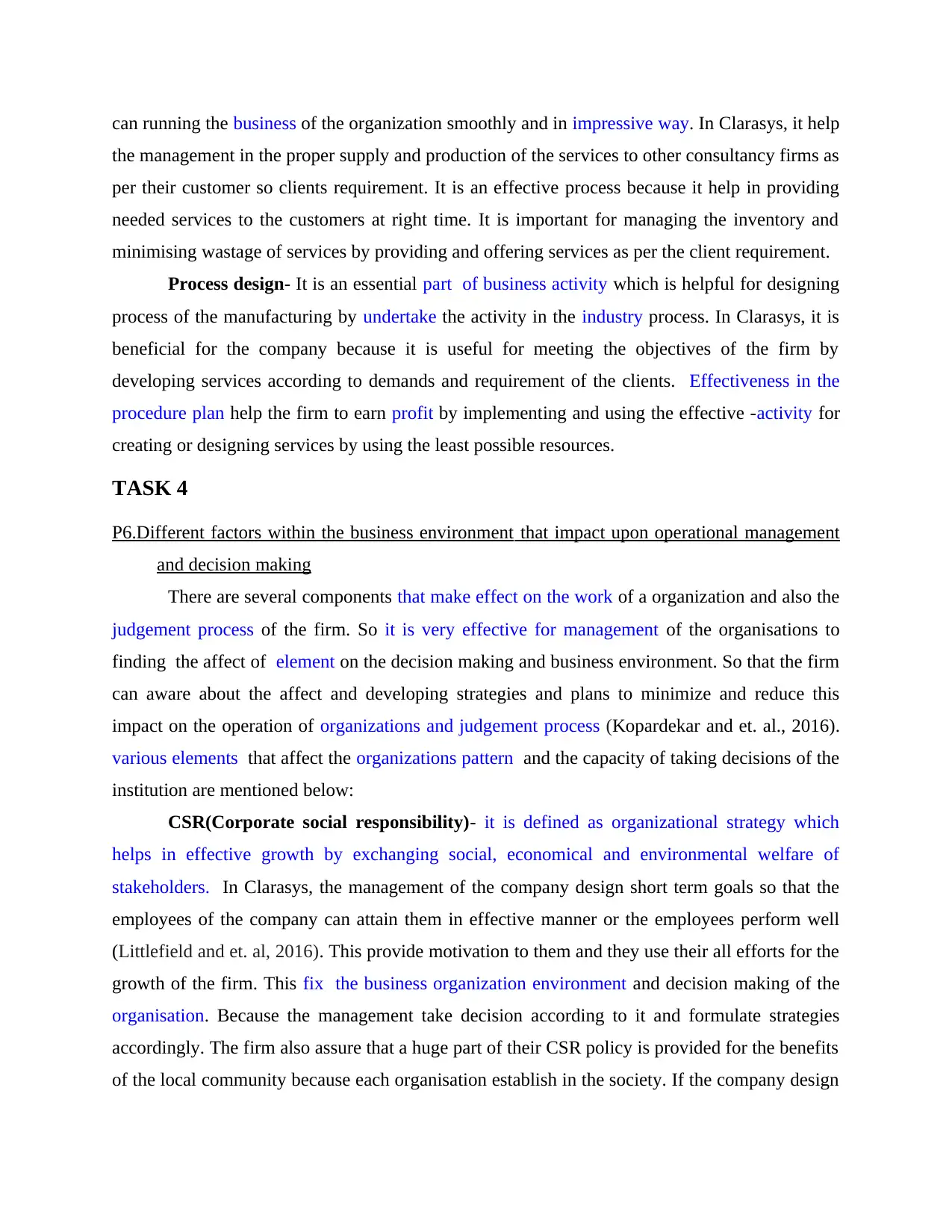
can running the business of the organization smoothly and in impressive way. In Clarasys, it help
the management in the proper supply and production of the services to other consultancy firms as
per their customer so clients requirement. It is an effective process because it help in providing
needed services to the customers at right time. It is important for managing the inventory and
minimising wastage of services by providing and offering services as per the client requirement.
Process design- It is an essential part of business activity which is helpful for designing
process of the manufacturing by undertake the activity in the industry process. In Clarasys, it is
beneficial for the company because it is useful for meeting the objectives of the firm by
developing services according to demands and requirement of the clients. Effectiveness in the
procedure plan help the firm to earn profit by implementing and using the effective -activity for
creating or designing services by using the least possible resources.
TASK 4
P6.Different factors within the business environment that impact upon operational management
and decision making
There are several components that make effect on the work of a organization and also the
judgement process of the firm. So it is very effective for management of the organisations to
finding the affect of element on the decision making and business environment. So that the firm
can aware about the affect and developing strategies and plans to minimize and reduce this
impact on the operation of organizations and judgement process (Kopardekar and et. al., 2016).
various elements that affect the organizations pattern and the capacity of taking decisions of the
institution are mentioned below:
CSR(Corporate social responsibility)- it is defined as organizational strategy which
helps in effective growth by exchanging social, economical and environmental welfare of
stakeholders. In Clarasys, the management of the company design short term goals so that the
employees of the company can attain them in effective manner or the employees perform well
(Littlefield and et. al, 2016). This provide motivation to them and they use their all efforts for the
growth of the firm. This fix the business organization environment and decision making of the
organisation. Because the management take decision according to it and formulate strategies
accordingly. The firm also assure that a huge part of their CSR policy is provided for the benefits
of the local community because each organisation establish in the society. If the company design
the management in the proper supply and production of the services to other consultancy firms as
per their customer so clients requirement. It is an effective process because it help in providing
needed services to the customers at right time. It is important for managing the inventory and
minimising wastage of services by providing and offering services as per the client requirement.
Process design- It is an essential part of business activity which is helpful for designing
process of the manufacturing by undertake the activity in the industry process. In Clarasys, it is
beneficial for the company because it is useful for meeting the objectives of the firm by
developing services according to demands and requirement of the clients. Effectiveness in the
procedure plan help the firm to earn profit by implementing and using the effective -activity for
creating or designing services by using the least possible resources.
TASK 4
P6.Different factors within the business environment that impact upon operational management
and decision making
There are several components that make effect on the work of a organization and also the
judgement process of the firm. So it is very effective for management of the organisations to
finding the affect of element on the decision making and business environment. So that the firm
can aware about the affect and developing strategies and plans to minimize and reduce this
impact on the operation of organizations and judgement process (Kopardekar and et. al., 2016).
various elements that affect the organizations pattern and the capacity of taking decisions of the
institution are mentioned below:
CSR(Corporate social responsibility)- it is defined as organizational strategy which
helps in effective growth by exchanging social, economical and environmental welfare of
stakeholders. In Clarasys, the management of the company design short term goals so that the
employees of the company can attain them in effective manner or the employees perform well
(Littlefield and et. al, 2016). This provide motivation to them and they use their all efforts for the
growth of the firm. This fix the business organization environment and decision making of the
organisation. Because the management take decision according to it and formulate strategies
accordingly. The firm also assure that a huge part of their CSR policy is provided for the benefits
of the local community because each organisation establish in the society. If the company design
Paraphrase This Document
Need a fresh take? Get an instant paraphrase of this document with our AI Paraphraser
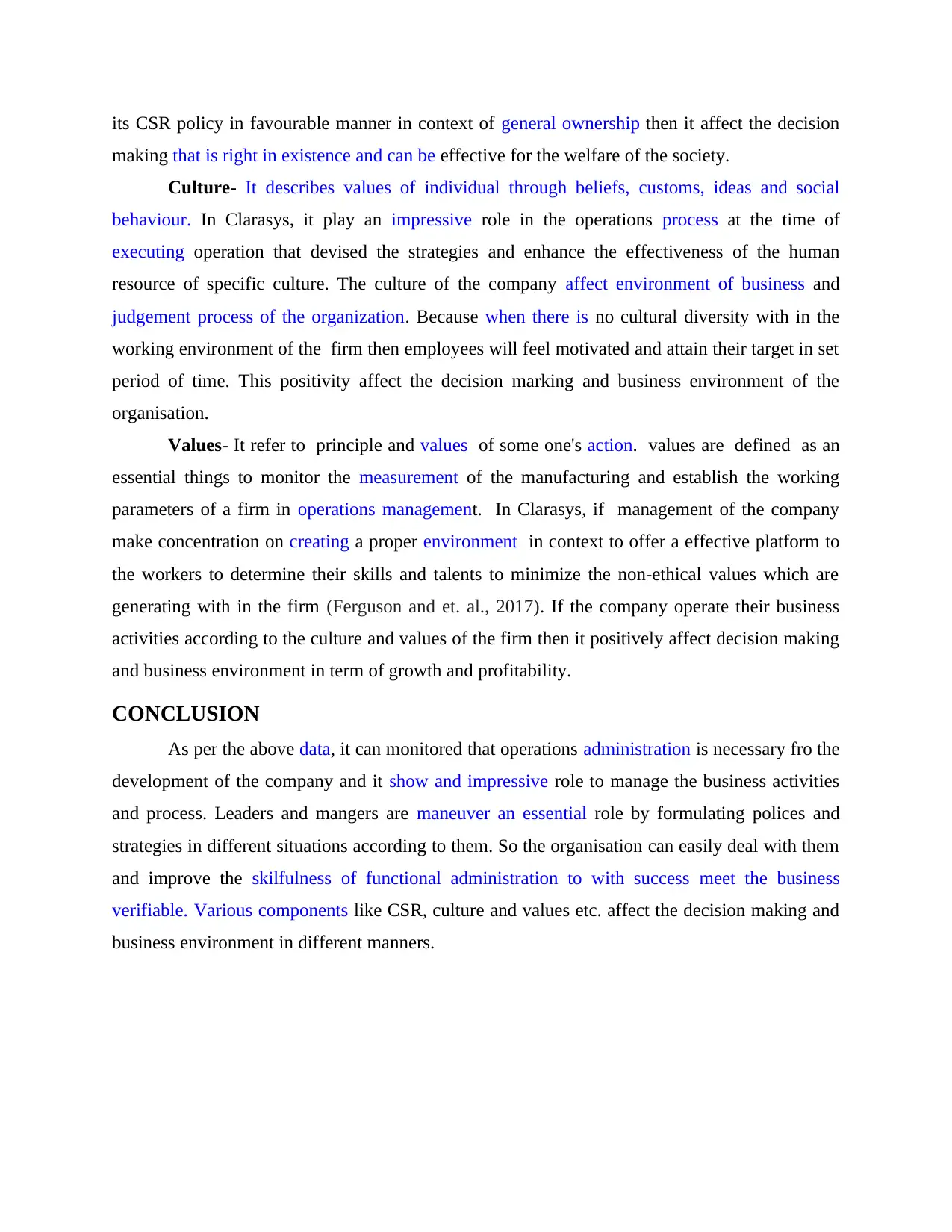
its CSR policy in favourable manner in context of general ownership then it affect the decision
making that is right in existence and can be effective for the welfare of the society.
Culture- It describes values of individual through beliefs, customs, ideas and social
behaviour. In Clarasys, it play an impressive role in the operations process at the time of
executing operation that devised the strategies and enhance the effectiveness of the human
resource of specific culture. The culture of the company affect environment of business and
judgement process of the organization. Because when there is no cultural diversity with in the
working environment of the firm then employees will feel motivated and attain their target in set
period of time. This positivity affect the decision marking and business environment of the
organisation.
Values- It refer to principle and values of some one's action. values are defined as an
essential things to monitor the measurement of the manufacturing and establish the working
parameters of a firm in operations management. In Clarasys, if management of the company
make concentration on creating a proper environment in context to offer a effective platform to
the workers to determine their skills and talents to minimize the non-ethical values which are
generating with in the firm (Ferguson and et. al., 2017). If the company operate their business
activities according to the culture and values of the firm then it positively affect decision making
and business environment in term of growth and profitability.
CONCLUSION
As per the above data, it can monitored that operations administration is necessary fro the
development of the company and it show and impressive role to manage the business activities
and process. Leaders and mangers are maneuver an essential role by formulating polices and
strategies in different situations according to them. So the organisation can easily deal with them
and improve the skilfulness of functional administration to with success meet the business
verifiable. Various components like CSR, culture and values etc. affect the decision making and
business environment in different manners.
making that is right in existence and can be effective for the welfare of the society.
Culture- It describes values of individual through beliefs, customs, ideas and social
behaviour. In Clarasys, it play an impressive role in the operations process at the time of
executing operation that devised the strategies and enhance the effectiveness of the human
resource of specific culture. The culture of the company affect environment of business and
judgement process of the organization. Because when there is no cultural diversity with in the
working environment of the firm then employees will feel motivated and attain their target in set
period of time. This positivity affect the decision marking and business environment of the
organisation.
Values- It refer to principle and values of some one's action. values are defined as an
essential things to monitor the measurement of the manufacturing and establish the working
parameters of a firm in operations management. In Clarasys, if management of the company
make concentration on creating a proper environment in context to offer a effective platform to
the workers to determine their skills and talents to minimize the non-ethical values which are
generating with in the firm (Ferguson and et. al., 2017). If the company operate their business
activities according to the culture and values of the firm then it positively affect decision making
and business environment in term of growth and profitability.
CONCLUSION
As per the above data, it can monitored that operations administration is necessary fro the
development of the company and it show and impressive role to manage the business activities
and process. Leaders and mangers are maneuver an essential role by formulating polices and
strategies in different situations according to them. So the organisation can easily deal with them
and improve the skilfulness of functional administration to with success meet the business
verifiable. Various components like CSR, culture and values etc. affect the decision making and
business environment in different manners.

⊘ This is a preview!⊘
Do you want full access?
Subscribe today to unlock all pages.

Trusted by 1+ million students worldwide
1 out of 13
Related Documents
Your All-in-One AI-Powered Toolkit for Academic Success.
+13062052269
info@desklib.com
Available 24*7 on WhatsApp / Email
![[object Object]](/_next/static/media/star-bottom.7253800d.svg)
Unlock your academic potential
Copyright © 2020–2025 A2Z Services. All Rights Reserved. Developed and managed by ZUCOL.





